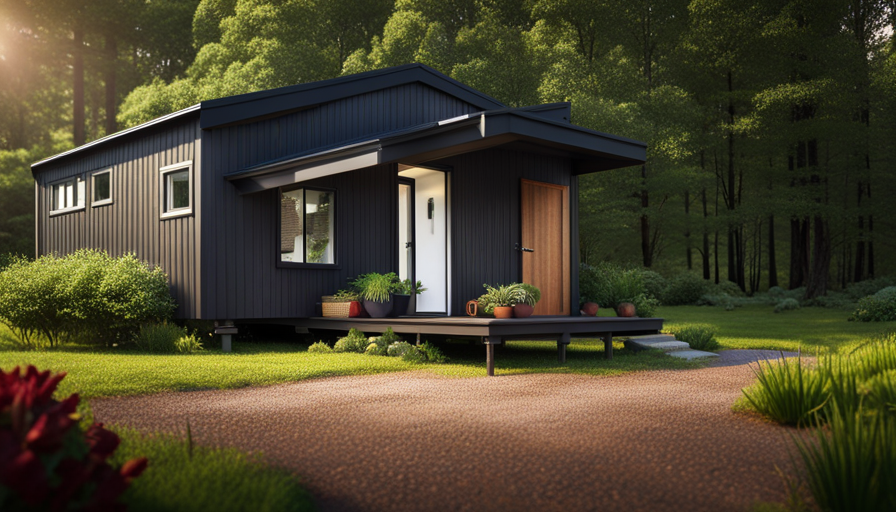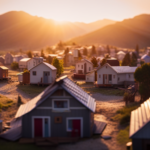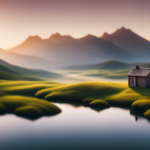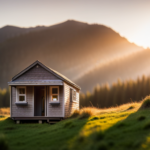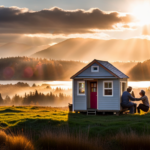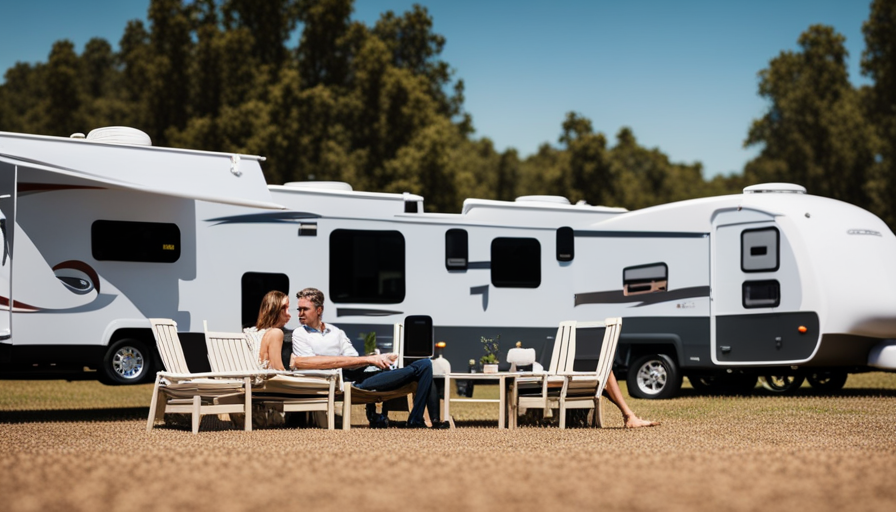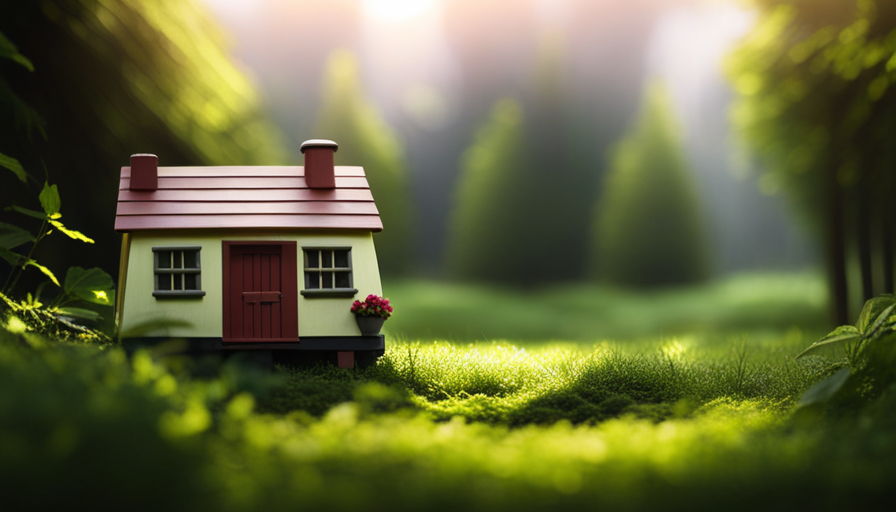In a world dominated by traditional homes, the concept of tiny houses emerged, providing a unique alternative to the typical living spaces. These small dwellings captured the attention of many, promising a simpler, more environmentally friendly way of life.
But amidst the enchantment lies a question that perplexes both dreamers and builders alike: what is the largest a tiny house can be? To unravel this mystery, we must embark on a journey of exploration and discovery, delving into the intricacies of size regulations, design innovations, and the boundaries that push the limits of tiny house living.
Join me as we navigate through the enchanting world of tiny houses, where every square foot holds the potential for infinite possibilities. Let us embark on this quest, dear reader, to uncover the secrets of the largest a tiny house can truly be.
Key Takeaways
- The largest size of a tiny house is determined by regulations and design innovations.
- Different areas have specific rules for maximum square footage of tiny houses, determined by zoning regulations.
- Typical size of tiny houses ranges from 100 to 400 square feet, offering lower costs and reduced environmental impact.
- Building larger tiny houses presents challenges such as finding suitable land, complying with building codes, ensuring structural integrity, and increased costs.
Understanding the Concept of Tiny Houses
You may think you understand the concept of tiny houses, but wait until you experience the cozy charm and incredible efficiency of these pint-sized dwellings. Exploring tiny house communities is a great way to truly grasp the essence of this movement.
These communities are vibrant and diverse, showcasing a wide range of designs and styles. From minimalist cabins to modern eco-friendly homes, there’s something for everyone.
Cost considerations for building a tiny house are also important to keep in mind. While they can be a more affordable housing option, there are still expenses to consider such as land, materials, and utilities. It’s essential to carefully plan and budget to ensure a successful project.
Now, let’s delve into exploring the different sizes of tiny houses and see what options are available.
Exploring the Different Sizes of Tiny Houses
With its dimensions compacted to resemble a cozy nest, these abodes epitomize the epitome of minimalistic living. Exploring the design of tiny houses is like navigating a world of creative possibilities within a confined space. From ingenious storage solutions to multifunctional furniture, every inch is utilized efficiently. However, the size of a tiny house is not only determined by its design but also by zoning regulations.
Different areas have specific rules regarding the maximum square footage allowed for a tiny house. These regulations vary widely, with some places defining a tiny house as anything under 400 square feet, while others set the limit at 1,000 square feet. Understanding these zoning regulations is crucial for anyone looking to build or live in a tiny house.
Transitioning into the subsequent section about defining the maximum square footage for a tiny house reveals the complexities involved in this aspect.
Defining the Maximum Square Footage for a Tiny House
Navigating the complexities of zoning regulations, you’ll discover that defining the maximum square footage for a compact dwelling like a tiny house requires careful consideration. Legal restrictions often dictate the size limitations of tiny houses, as they aim to ensure safety and maintain the aesthetic appeal of the surrounding area.
While there is no universal maximum square footage for tiny houses, they typically range from 100 to 400 square feet. This smaller size offers several advantages, including lower construction and maintenance costs, reduced environmental impact, and greater mobility. Additionally, a smaller space encourages a simpler and more efficient lifestyle. By embracing minimalism and maximizing functionality, tiny house owners can enjoy a clutter-free living environment that meets their needs.
Transitioning into the subsequent section about legal considerations for tiny house size, it is important to understand the specific regulations and requirements imposed by local authorities.
Legal Considerations for Tiny House Size
Explore the legal maze surrounding size restrictions for compact dwellings like tiny houses and uncover the key considerations to ensure compliance with local regulations.
- One of the main challenges when it comes to tiny house regulations is navigating the complex web of zoning laws. These laws vary from one jurisdiction to another, making it crucial to do thorough research and understand the specific regulations in your area.
- Another important consideration is the definition of a tiny house in your local jurisdiction. Some areas may have specific size limits, while others may focus on other factors such as mobility or foundation type.
- Additionally, there may be restrictions on where you can park or place your tiny house. Some areas may require a permanent foundation, while others may allow for temporary placements.
By understanding the legal considerations and restrictions imposed by local regulations, you can ensure that your tiny house complies with all necessary requirements. This will set the stage for exploring innovative design ideas for maximizing space in your tiny house.
Innovative Design Ideas for Maximizing Space in Tiny Houses
One clever trick for optimizing space in compact dwellings is by incorporating hidden storage compartments, like secret drawers or concealed cabinets, to create a sense of wonder and surprise in your cozy abode. In addition to these innovative design ideas, maximizing storage in a tiny house can also be achieved through the use of multi-purpose furniture.
For example, a dining table that doubles as a work desk or a sofa that converts into a bed can save valuable space. Another space-saving technique is to utilize vertical storage solutions, such as wall-mounted shelves or hanging organizers. These strategies not only maximize storage but also create a more organized and efficient living environment.
Transitioning into the subsequent section about the benefits of living in a larger tiny house, it is important to consider the advantages of having more space to accommodate your needs and preferences.
Benefits of Living in a Larger Tiny House
Having more room in a larger compact dwelling allows for greater flexibility and customization to suit individual preferences and needs. Expanding a tiny house provides the opportunity for spacious living, which comes with several benefits.
- Interior Layout: With a larger tiny house, there’s room to design separate areas for sleeping, working, and relaxing, creating a more functional living space.
- Storage Solutions: More square footage means additional storage options, such as built-in cabinets, shelves, and closets, helping to keep the space organized and clutter-free.
These advantages make living in a larger tiny house more comfortable and convenient. However, it’s essential to recognize that building a larger tiny house also presents challenges and limitations. These include increased costs, potential zoning restrictions, and the need for specialized construction techniques.
Transitioning into the subsequent section, let’s explore the challenges and limitations of building a larger tiny house.
Challenges and Limitations of Building a Larger Tiny House
Building a bigger compact dwelling may come with its fair share of challenges and limitations that you need to be aware of. As the size of a tiny house increases, so do the difficulties in construction and design. One major challenge is finding suitable land to accommodate a larger tiny house. Limited availability and zoning restrictions can make it difficult to find a suitable location. Additionally, building codes and regulations may pose limitations on the maximum size of a tiny house. Structural integrity is also a concern, as larger tiny houses may require additional support to ensure stability. Furthermore, the cost of building a larger tiny house can significantly increase, both in terms of materials and labor. Despite these challenges and limitations, there are creative ways to expand the living space in a tiny house without compromising its compact nature.
Creative Ways to Expand the Living Space in a Tiny House
In my previous discussion of the challenges and limitations of building a larger tiny house, I highlighted the difficulties inherent in expanding the living space. However, there are creative solutions that can help overcome these obstacles and maximize the available area.
One such approach is expanding vertically, utilizing the often underutilized vertical space in a tiny house. By incorporating loft areas or mezzanines, it’s possible to create additional sleeping or storage areas without sacrificing the overall footprint.
Another strategy involves making the most of outdoor space. This can be achieved through the addition of outdoor living areas, such as decks or patios, which effectively extend the usable square footage.
These innovative solutions allow for an enhanced living experience within the confines of a tiny house.
Transitioning into the next section, let’s explore some examples of large tiny houses that push the boundaries of what’s possible.
Examples of Large Tiny Houses That Push the Boundaries
Outrageously oversized and over-the-top, these colossal compact dwellings defy boundaries and blur the line between tiny and tremendous.
- Innovative Layout: Large tiny house designs challenge traditional floor plans by incorporating multi-levels, lofts, and hidden storage solutions to maximize space utilization.
- Luxurious Amenities: High-end finishes such as granite countertops, stainless steel appliances, and spa-like bathrooms elevate the tiny house living experience to new heights.
- Expansive Windows: Floor-to-ceiling windows flood the interior with natural light, creating an illusion of spaciousness and connecting the occupants with the outdoors.
- Smart Technology Integration: Cutting-edge automation systems control lighting, temperature, and security, providing convenience and efficiency in these compact spaces.
- Outdoor Extensions: Large decks, rooftop gardens, and retractable awnings expand the living area beyond the confines of the house, blurring the boundaries between indoor and outdoor living.
Transitioning into the subsequent section about ‘making the decision: choosing the right size for your tiny house,’ it’s essential to consider these innovative designs and unique features when determining the perfect size for your own tiny house.
Making the Decision: Choosing the Right Size for Your Tiny House
When it comes to choosing the right size for your tiny house, there are several factors to consider. It’s important to remember that the whole point of a tiny house is to maximize functionality and minimize space. Therefore, determining the size of your tiny house should be a thoughtful and deliberate decision.
One key factor to consider is your lifestyle and needs. Are you a minimalist who only requires the bare essentials, or do you have a lot of belongings that need to be accommodated? Additionally, think about the number of occupants and their comfort. Will you be living alone or with a partner? Do you plan on having guests over frequently?
Another consideration is the location where you plan to park your tiny house. Some areas have restrictions on the size of tiny houses, so it’s important to research and comply with local regulations.
By carefully evaluating these factors, you can choose the right size for your tiny house that perfectly suits your needs and lifestyle.
Frequently Asked Questions
Are there any building codes or regulations that limit the size of a tiny house?
Yes, there are building codes and regulations that impose size limitations on tiny houses. These regulations vary depending on the location and jurisdiction, but they generally exist to ensure safety, proper sanitation, and adherence to zoning ordinances. Building codes may dictate the minimum square footage, ceiling height, and access requirements for tiny houses. These limitations aim to prevent overcrowding, maintain structural integrity, and protect the well-being of occupants. Compliance with these regulations is essential to ensure a legal and safe tiny house construction.
Can a tiny house be considered a permanent residence?
Yes, a tiny house can be considered a permanent residence. Many people choose to live in tiny houses as a way to reduce their environmental impact and live a more sustainable lifestyle. Tiny houses can be eco-friendly, as they often use less energy and resources compared to traditional homes.
However, there are some common misconceptions about tiny house living, such as limited space and lack of comfort. In reality, with smart design and organization, tiny houses can be both functional and comfortable.
What are the potential benefits of living in a smaller tiny house, as opposed to a larger one?
Living in a smaller tiny house offers numerous benefits of downsizing. Firstly, it promotes a simpler and minimalist lifestyle, reducing the accumulation of unnecessary possessions. This can lead to less stress and a greater sense of contentment.
Secondly, smaller tiny houses have a smaller environmental footprint, requiring fewer resources for construction and maintenance. This contributes to environmental sustainability by reducing energy consumption and waste generation.
Overall, downsizing to a smaller tiny house has positive social, psychological, and environmental impacts.
Are there any financing options available for building a larger tiny house?
There are financing options available for building a larger tiny house. One example is obtaining a construction loan from a bank or credit union. These loans typically require a down payment and have specific requirements, such as proof of income and a detailed construction plan.
Additionally, it’s important to consider building regulations when planning a larger tiny house, as some municipalities may have size limitations or other restrictions in place.
How can I maximize storage space in a larger tiny house?
To maximize storage space in a larger tiny house, I recommend implementing creative storage solutions. Utilize under-the-stairs storage, built-in shelves, and multi-functional furniture. Install wall-mounted organizers, hooks, and magnetic strips to efficiently store items. Opt for furniture with hidden compartments or storage space underneath. Utilize vertical space by installing shelves or cabinets up to the ceiling. By employing these strategies, you can effectively maximize storage capacity in your larger tiny house.
Conclusion
In conclusion, after exploring the concept of tiny houses and the maximum square footage they can have, it’s clear that there are limitations to consider.
While some may argue that a larger tiny house could provide more living space, it’s important to remember that the essence of a tiny house lies in its compactness and simplicity.
By embracing innovative design ideas and maximizing space, it’s possible to create a comfortable and functional living environment within the constraints of a tiny house.
So, let’s embrace the challenge and create a cozy haven within the confines of a small space.
I’m Theodore, and I love tiny houses. In fact, I’m the author of Tiny House 43, a book about tiny houses that are also tree houses. I think they’re magical places where imaginations can run wild and adventures are just waiting to happen.
While tree houses are often associated with childhood, they can be the perfect adult retreat. They offer a cozy space to relax and unwind, surrounded by nature. And since they’re typically built on stilts or raised platforms, they offer stunning views that traditional homes simply can’t match.
If you’re looking for a unique and romantic getaway, a tree house tiny house might just be the perfect option.

